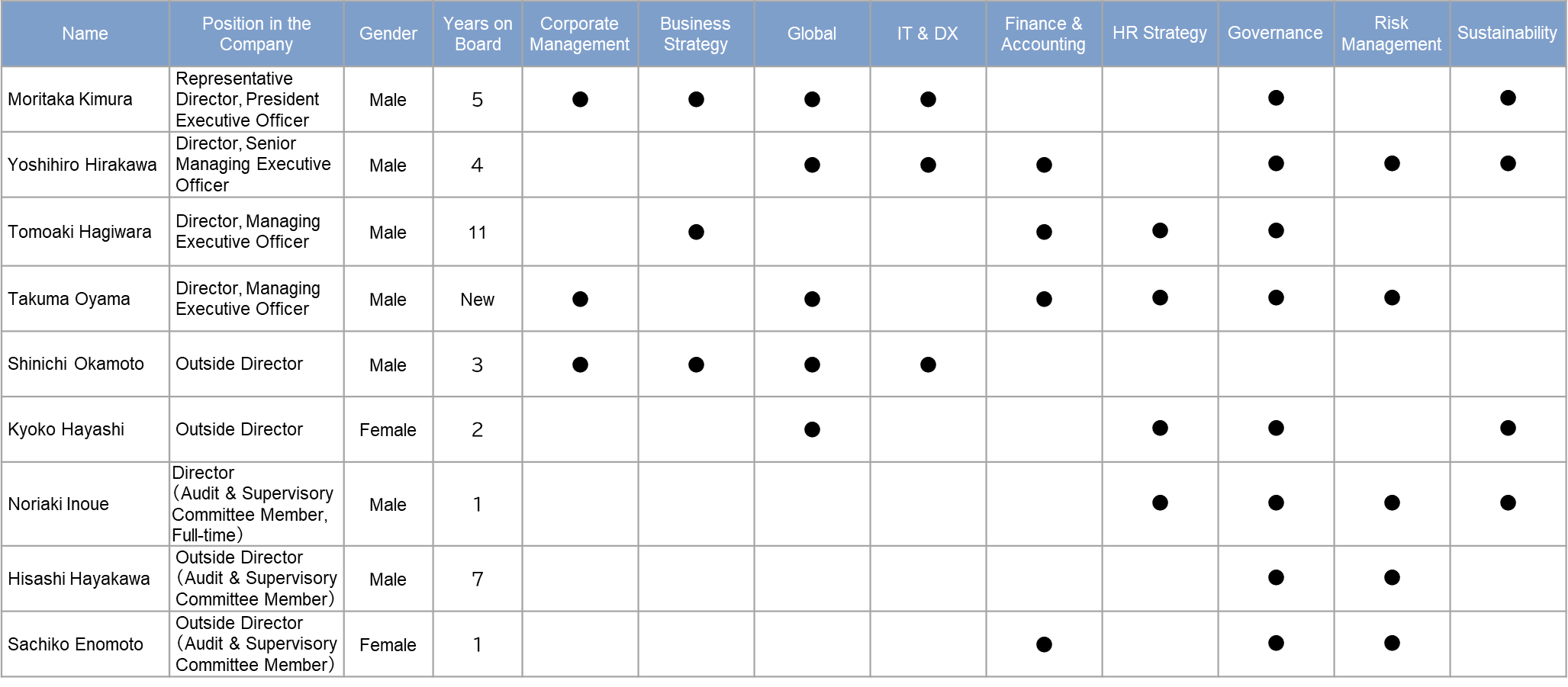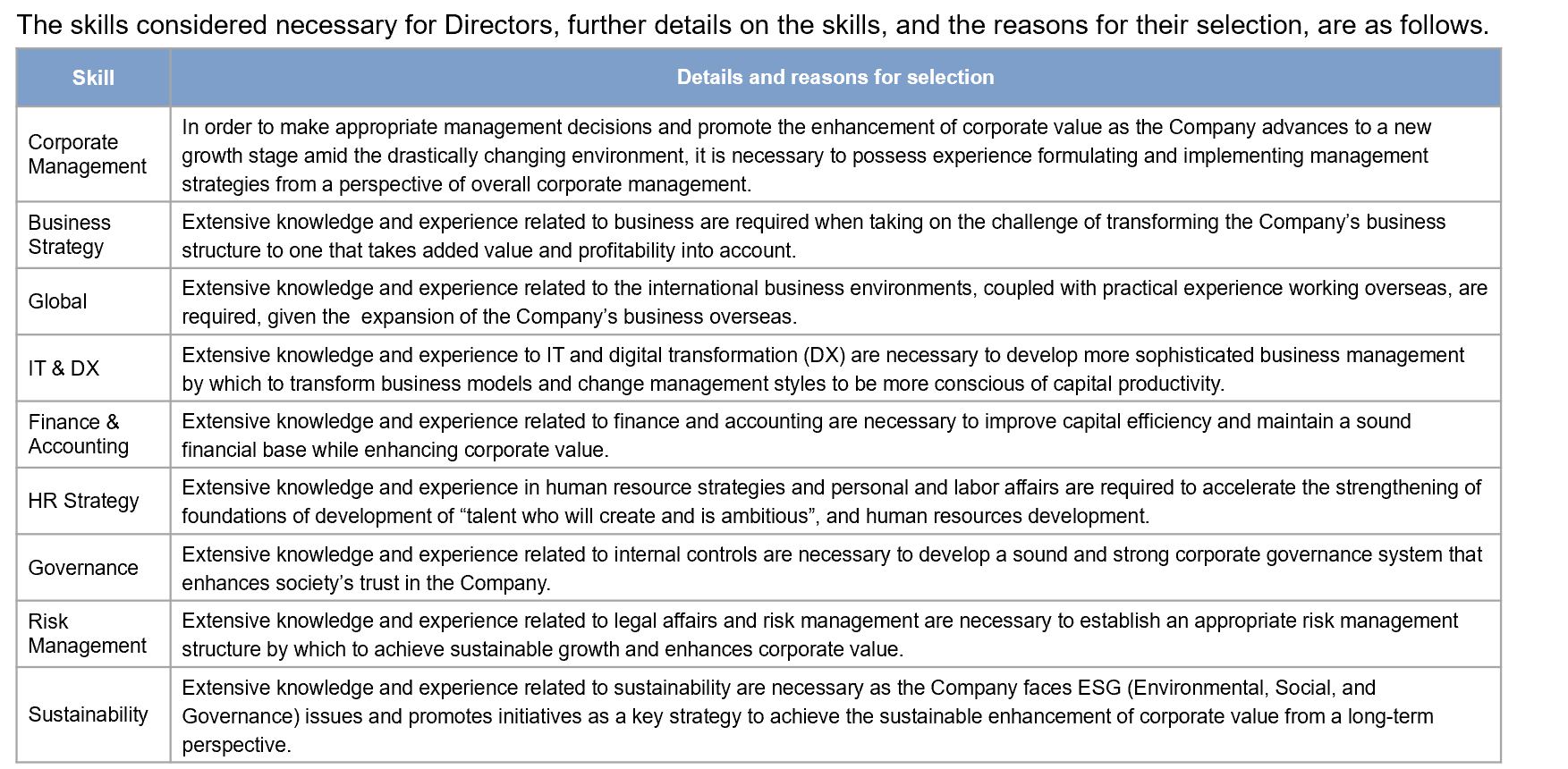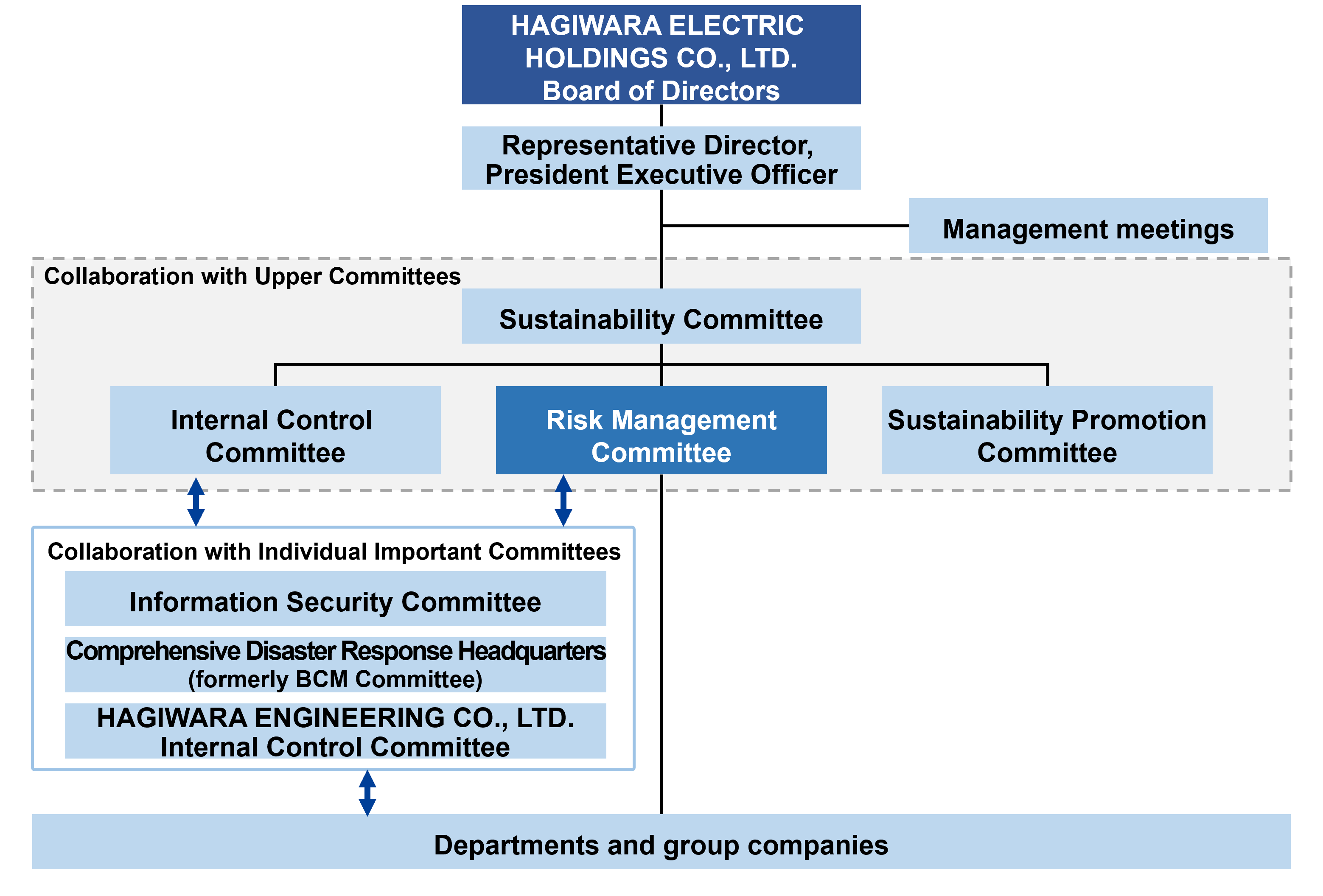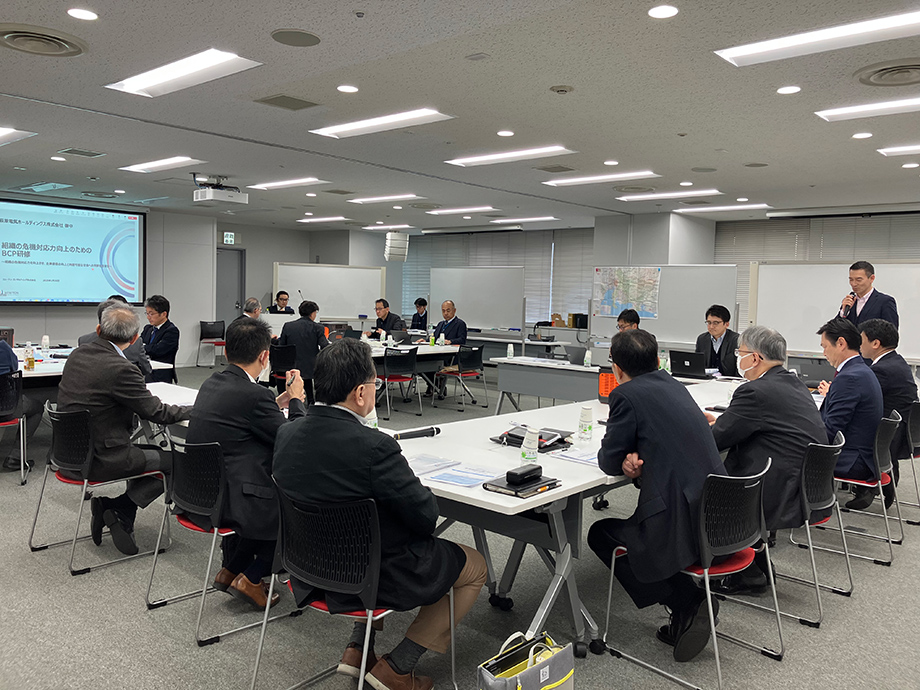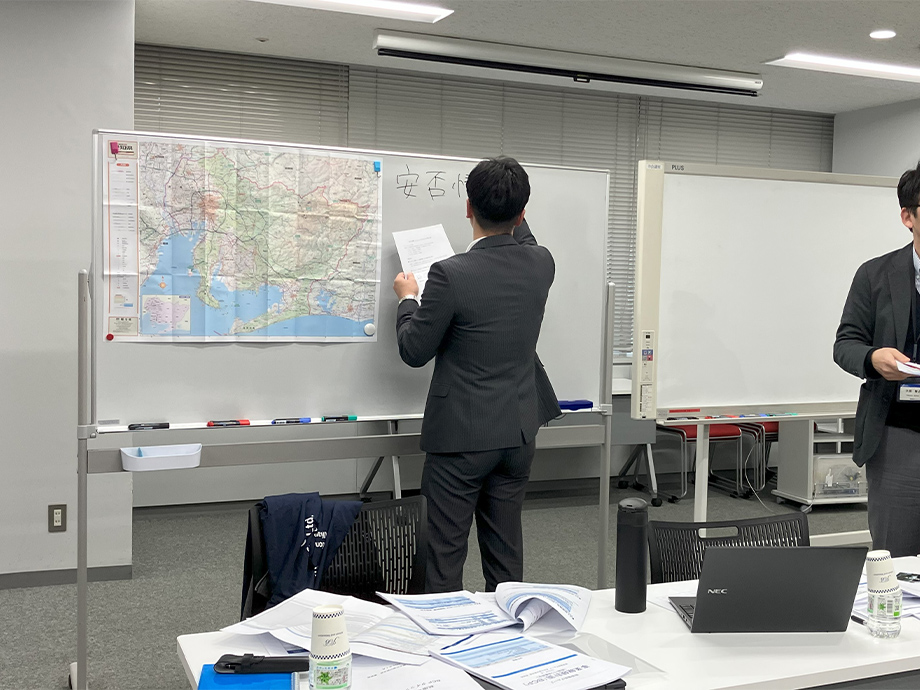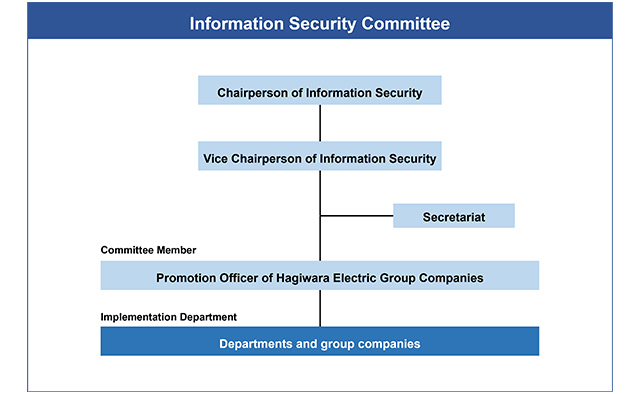Our Business Our Business Top CLOSE
- Our Business
- Our Company
-
IR Info
IR Info IR Info Top CLOSE
- Sustainability
- Home
- Sustainability
- Governance
Governance
Corporate Governance
Basic Approach
The Hagiwara Electric Group is fully aware of the importance of corporate governance, and we are working to improve the transparency and soundness of our management. Compliance is at the heart of corporate governance. In all our business activities, not only do we strictly comply with laws and regulations, but we also act with the awareness that we are a member of society.
Corporate Governance System
As a pure holding company, we have adopted the structure of a company with an Audit and Supervisory Committee. Our Board of Directors currently consists of six Directors (including two outside Directors, and excluding the Directors who are members of the Audit and Supervisory Committee) and three Directors who are members of the Audit and Supervisory Committee (including two outside Directors).
The three Directors who are on the Audit and Supervisory Committee constitute the Audit and Supervisory Committee, and one of those Directors is a full-time member of the Audit and Supervisory Committee. To ensure the effectiveness of corporate governance while enabling swift and agile business execution, we have introduced an executive officer system that clearly delineates the roles of decision-making and supervisory functions from those of business execution. Under this system, executive officers are responsible for executing operations according to their rank, and Directors are appointed from among executive officers at a certain level or above.
Our Directors (excluding the Directors who are members of the Audit and Supervisory Committee) attend monthly management meetings to discuss and report on the overall management of the Hagiwara Electric Group. The full-time Audit and Supervisory Committee member attends management meetings as an observer.
Furthermore, with the aim of cross-sectionally promoting overall initiatives for corporate governance and sustainability management at all group companies, we have established our Sustainability Committee, which is chaired by our Representative Director, President Executive Officer. The Sustainability Committee regularly verifies compliance and the appropriateness and effectiveness of internal control systems, and makes improvements and corrections regarding problem points. It also strengthens risk management and works on resolving various issues related to the SDGs and ESG.
With regard to external audits, we have signed an audit agreement with KPMG AZSA LLC, and they conduct accounting audits and internal control audits from an independent standpoint.
Reasons for Choosing the Current Corporate Governance System
The Hagiwara Electric Group transitioned to a pure holding company structure on April 1, 2018. As a holding company, we have established a Board of Directors, an Audit and Supervisory Committee, and an accounting auditor, and each operating subsidiary has also established its own Board of Directors and auditors in order to achieve balance between management monitoring and business execution, as well as to ensure highly transparent management and improved agility of the Group as a whole.
-
-
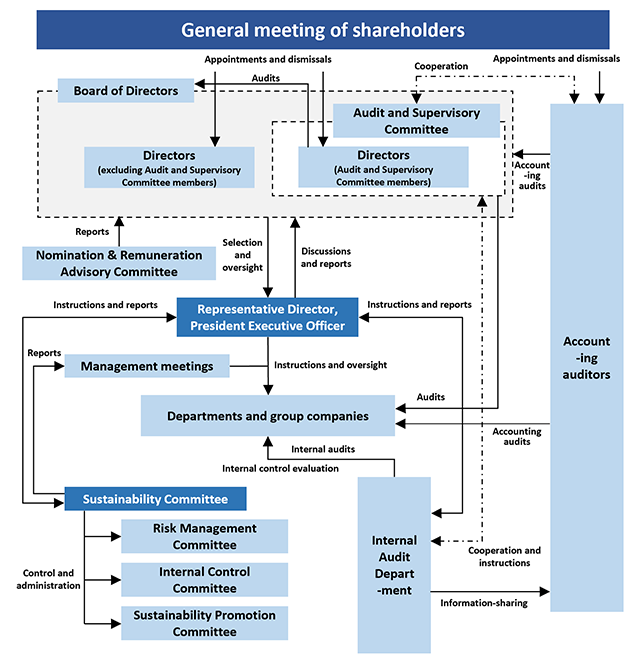
- Corporate Governance Chart (as of April 1, 2025)
-
Governance Quick Reference Table
| Corporate Governance Structure | Company with an Audit and Supervisory Committee |
|---|---|
| Number of Directors who are not Audit and Supervisory Committee members Number of Directors who are Audit and Supervisory Committee members |
6 (including Two Outside Directors) 3 (including Two Outside Directors) |
| Chairperson of the Board of Directors | President |
| Term of Office for Directors who are not Audit and Supervisory Committee members Term of Office for Directors who are Audit and Supervisory Committee members |
1 year 2 years |
| Executive Officer System | In Place |
| Voluntary Advisory Committee under the Board of Directors | Establishment of the Nomination and Remuneration Advisory Committee |
| Accounting Auditor | KPMG AZSA LLC |
Enhancement of Board of Directors’ Functions
Matrix of Skills Held by Directors
The Hagiwara Electric Group appoints multiple outside Directors who maintain a certain distance from the execution of business operations. Our Board of Directors is composed within the scope defined by the Companies Act and our Articles of Incorporation, ensuring that it effectively fulfills its roles and responsibilities. The board is structured to maintain a well-balanced combination of knowledge, experience, and capabilities, while achieving both diversity and appropriate size.
The matrix of skills held by Directors is as follows.
- The list above indicates the areas where each of the Directors can demonstrate more expertise based on their experience. etc., and does not show all insights held by them.
The skills considered necessary for Directors, further details on the skills, and the reasons for their selection, are as follows.
Evaluation of the Board of Directors' Effectiveness
To improve the functionality of the Board of Directors, we conduct analysis and evaluation of its effectiveness.
<Process>
All Directors participate in a self-assessment survey covering seven key areas, including board composition and operations. The survey combines a five-point rating scale with open-ended comments. The results are analyzed and discussed within the Board of Directors to facilitate evaluation and improvement. To ensure objectivity and encourage candid feedback, the self-assessment and analysis are conducted with the support of an external organization. Responses are submitted directly to the external organization to maintain anonymity.
<Evaluation Results>
As a result of the evaluation conducted for FY2024, it was confirmed that there is a shared recognition that the effectiveness of the Board of Directors is generally being maintained as in the previous year. On the other hand, several areas were identified as ongoing challenges. These include the composition of the Board, the adequacy of Directors’ skills in relation to the Company’s management strategy, securing sufficient time for board discussions, the timing of material distribution, the number of agenda items, and the need for more in-depth discussions on topics such as management strategy, business plans, human capital, and internal environment development policies. Additionally, the structure for facilitating constructive dialogue with shareholders was recognized as an area requiring further consideration.
Going forward, we will continue working to enhance the effectiveness of the Board of Directors by addressing the issues identified through this evaluation.
Overview for "Appointment Standards and Independence Standards for Outside Directors"
The Company has established the "Appointment Standards and Independence Standards for Outside Directors", and appoints outside Directors who satisfy the criteria of these standards as independent officers.
In addition to the requirements for externality under the Companies Act, appointees shall possess a sincere personality, a high level of insight and capability, broad-ranging knowledge and experience and a record of achievements.
Of the outside Directors, outside officers who do not fall under any of the following items shall be determined to have independence.
- Any person who is a major shareholder of the Company or an executive thereof
- Any person whose major business partner is the Group (with transactions valued at 2% or more of the person's consolidated net sales in the most recent fiscal year), or an executive thereof
- Any person who is a major business partner of the Group (with transactions valued at 2% or more of the Group’s consolidated net sales in the most recent fiscal year), or an executive thereof
- An accounting auditor of the Group, or a person who is responsible for the audit operation of the Group as an employee of the accounting auditor
- An attorney, judicial scrivener, patent attorney, certified public accountant, tax accountant, consultant, or equivalent who receives, apart from compensation for officers, money or other property equivalent to more than 10.0 million yen per year from the Group
- A major lender to the Group or an executive thereof
- Any person who has fallen under any of (1) through (6) avobe during the past three years
- Any person other than the aforementioned items with special circumstances which preclude him/her from fulfilling duties as an independent outside officer or Audit and Supervisory Board Member, such as having conflicts of interest with the Company
Director Training
Newly appointed Directors receive onboarding training, during which they are provided with essential legal knowledge and an explanation of their expected roles and responsibilities. In addition, we conduct annual compliance training for all Directors and offer opportunities to participate in external seminars and networking events to support the acquisition of necessary knowledge and a deeper understanding of their duties.
For outside Directors, we also provide explanations of the Company’s business operations, financial status, and other relevant matters as needed.
Outline of the System
Nomination & Remuneration Advisory Committee
As a voluntary advisory body to the Board of Directors, the Company has established the Nomination and Remuneration Advisory Committee. The committee consists of two internal Directors and four outside Directors (including four independent outside Directors), ensuring that independent Directors form the majority. The committee deliberates on matters related to the nomination and remuneration of Directors that are referred by the Board of Directors, and provides recommendations regarding their appropriateness and other relevant considerations.
The Board of Directors makes decisions regarding the nomination and remuneration of Directors based on the recommendations provided by the Nomination and Remuneration Advisory Committee. The matters to be deliberated by the committee upon referral from the Board, as well as the composition of the committee members, are as follows.
<Matters for Deliberation>
- Matters related to candidates for Director appointments
- Matters related to the selection and dismissal of Representative Directors
- Matters related to the appointment and dismissal of Directors with specific titles
- Matters related to the remuneration structure for Directors and the determination of such remuneration
- Matters related to the details of individual Directors’ compensation
- Matters related to the formulation and implementation of the succession plan
- Other matters deemed necessary by the Board of Directors
Coordination among the Audit and Supervisory Committee, Accounting Auditor, and Internal Audit Department
The Audit and Supervisory Committee conducts audits covering the execution of duties by Directors, the overall status of operations related to group management, the accuracy of business reports and other disclosures, the appropriateness of audits conducted by the Accounting Auditor, and the effectiveness of the internal control systems. Regarding accounting audits, the Audit and Supervisory Committee holds quarterly meetings with the Accounting Auditor to facilitate mutual coordination through discussions, reporting, and information exchange—such as sharing identified risks during audit planning and audit results.
The full-time member of the Audit and Supervisory Committee collaborates with the Internal Audit Department by participating in internal audits. Additionally, the Committee convenes a monthly Audit Liaison Meeting, composed of Audit & Supervisory Board Members of group companies and the Chairperson of the Internal Control Committee, to gather information and enhance the audit environment.
Policy on Compensation for Officers
Policy on Determination of Compensation Amounts and Calculation Methods
The Company has established the following basic policy regarding the determination of the amount of compensation for officers or the methods of its calculation.
Basic Policy on Determination of Compensation for Officers
As “An Engineering Solution Partner That Is Connecting Human, Society and Technology, Through Advanced Electronics,” we aim to reform our structure and establish a business foundation and increase our corporate value (earning power) in order to achieve sustainable and further business growth. In order to motivate the achievement of the structural reforms and key management indicators outlined in our management policy, and ultimately the medium- to long-term enhancement of corporate value, we will revise and implement the officer compensation system based on the following aims.
- Motivate the entire company and individual Directors through performance indicators to improve corporate value over the medium to long term
The amount of performance-linked compensation (bonuses) is determined based on the degree of achievement of financial indicators and individual targets related to achieving management indicators important for the achievement of the medium-term management plan, increasing profits returned to shareholders, and improving individual performance. - Motivate employees to fulfill their expected roles to improve corporate value over the medium to long term
Compensation levels and variable ratios shall be set based on the magnitude of their roles and responsibilities in the executive officer system in order to motivate the enhancement of company-wide performance and further fulfillment of roles and responsibilities. - Improvement of alignment of interests and accountability to stakeholders
- We evaluate non-financial initiatives such as promotion of the human capital management and qualitative initiatives based on each Director’s mission to enhance corporate value.
- We grant restricted stock compensation to Directors (excluding Audit & Supervisory Committee Members and outside Directors) to further improve the alignment of interests with shareholders.
Policy for Determining the Amount and Calculation Method of Compensation for Officers
The details of the policy for determining the content of compensation, etc. for each individual Director are as follows.
- Policy on compensation levels
In determining the compensation of individual Directors, the amount of compensation shall be set in accordance with the scale of their roles, referring to the market compensation level at Japanese companies, such as compensation data from external professional organizations. - Policy on compensation structure
The compensation for Directors (excluding Audit & Supervisory Committee Members and outside Directors) consists of (i) basic compensation (monetary compensation), (ii) performance-linked compensation (bonuses), and (iii) restricted stock compensation, as compensation for execution of duties. As compensation for oversight, a Representative Director allowance is paid to the Representative Director and a Director allowance is paid to Directors. Compensation for Directors who are Audit & Supervisory Committee Members and outside Directors shall consist only of basic compensation (monetary compensation) in consideration of their responsibilities. - Policy for determining the amount of compensation, etc. by individual for basic compensation (monetary compensation) (including policy regarding determination of timing or conditions for granting compensation)
Basic compensation (monetary compensation) is a fixed monthly amount, and the amount of compensation for each individual is determined by adding the Representative Director allowance or a Director allowance to the base amount based on their role. - Details of performance-linked compensation (bonuses), etc. and policy regarding determination of the amount or calculation method of the number of such compensation (including policy regarding determination of timing or conditions for granting compensation)
Performance-linked compensation (bonuses) refers to performance-linked monetary compensation paid in accordance with the Group’s consolidated performance and individual evaluation during each fiscal year. The payment rate varies depending on performance in relation to the base amount set by role. Individual bonus amounts are determined based on the achievement of targets for consolidated net sales, consolidated profit, consolidated ROE, non-financial indicators, and individual evaluations. The bonuses are paid each year at a specific time.
In principle, the payment rate and bonus amount are determined based on the results of the Group’s consolidated performance and individual evaluation, but in the case of an unforeseen business environment, adjustments (lower limits) to the payment rate may be applied in consideration of each company’s and individual’s performance under such circumstances. - Details of restricted stock compensation, etc. and policy regarding determination of the amount or calculation method of the number of such compensation (including policy regarding determination of timing or conditions for granting compensation)
Restricted stock refers to non-monetary compensation granted for the further improvement of alignment of interests with shareholders. The monetary compensation claims, which are set in accordance with roles, are paid to each Director (excluding Audit & Supervisory Committee Members and outside Directors), and all of such monetary compensation claims are paid at a certain time each year by way of contribution in kind to receive an allotment of restricted stock with transfer restrictions until the expiration of the restricted transfer period. - Policy on the ratio of compensation, etc.
For the percentage of compensation by type of Director (excluding Audit & Supervisory Committee Members and outside Directors), will be considered by referring to benchmark ratios from compensation data of external professional institutions, including all Japanese companies and peer companies in the same industry. The Representative Director, President Executive Officer delegated authority under (7) respects the recommendations of the Nomination & Remuneration Advisory Committee and determines the contents of each Director’s individual compensation with reference to the ratios of each type indicated in the recommendations.
Specifically, with emphasis on Group consolidated performance and enhancement of corporate value, the ratio of basic compensation (monetary compensation) to performance-linked compensation (bonuses) and restricted stock compensation (linked to short- and medium-to-long-term performance) for the Representative Director, President Executive Officer is set to be approximately equal, while for other Directors, the payout ratios are set so that the magnitude of roles and variable ratios are linked. - Matters concerning decisions on the content of individual Director compensation, etc.
The composition of compensation for each individual Director (excluding Audit & Supervisory Committee Members) and the calculation standards for each type of compensation shall be determined by the Board of Directors after consulting with and receiving a recommendation from the Nomination & Remuneration Advisory Committee, in order to ensure transparency and objectivity in the compensation determination process.
The specific amount of compensation for each individual shall be delegated by the Representative Director, President Executive Officer based on a resolution of the Board of Directors, and the content of such delegation shall be the monthly basic compensation (monetary compensation) and the final amount and timing of payment of performance-linked compensation (bonuses). The Board of Directors shall consult with the Nomination & Remuneration Advisory Committee and obtain its recommendation to ensure that such authority is properly exercised by the Representative Director, President Executive Officer, and the Representative Director, President Executive Officer, to whom the above authority is delegated, shall make decisions in accordance with the content of such recommendation. In addition, the number of shares of restricted stock allocated individually to Directors is resolved by the Board of Directors in accordance with the standards recommended by the Nomination & Remuneration Advisory Committee.
Cross-Shareholdings
- Policy on cross-shareholdings
The Company may hold shares (below, “cross-shareholdings”) when it is deemed necessary for purposes such as the stable procurement and supply of electronic components and the maintenance and strengthening of business relationships, comprehensively considering strategic importance to its business strategies, cooperative relationships with counterparties, and contribution to the sustainable development of its business and medium- to long-term enhancement of corporate value. However, the rationale for holding cross-shareholdings will be reviewed annually, and any stock whose rationale for holding is deemed to have declined will be sold as appropriate. - Method for verifying the appropriateness of cross-shareholdings
Every year, the Board of Directors examines the economic rationale, significance, etc. of each individual stock and reviews whether to continue holding them. The economic rationale is verified based on quantitative criteria such as whether dividends, share price trends, and contributions to the Company’s profits are commensurate with the cost of capital, while the significance of holding is verified from a long-term, strategic perspective regarding stable procurement and supply of electronic components and the building and maintaining of smooth business relationships. - Standards for exercising voting rights pertaining to cross-shareholdings
The basic policy when exercising voting rights for cross-shareholdings held by the Group is to exercise them in a manner that contributes to the sustainable development of the Group’s business and the medium- to long-term enhancement of corporate value, and as a general rule, to vote in favor. However, for the following proposals requiring careful consideration that may cause significant loss of shareholder rights or shareholder value, approval or disapproval shall be determined after individual examination from the perspective of the above basic policy.- Proposals on the reappointment and compensation of officers
- If the Company has recorded a loss for two or more consecutive fiscal years
- If the Company has been involved in a social scandal
- Proposals to amend the Articles of Incorporation
- If there is a risk that shareholder rights or shareholder value may be significantly impaired
- Other agenda items
- If there is a risk that shareholder rights or shareholder value may be significantly impaired due to reorganization, takeover defense measures, shareholder proposals, etc.
- Proposals on the reappointment and compensation of officers
In addition, in order to exercise voting rights appropriately in accordance with the above standards, when considering whether to approve or disapprove proposals requiring careful consideration, the Company will obtain opinions from the relevant departments and, if necessary, engage in dialogue with the company issuing the shares.
Dialogue with Shareholders and Investors
Basic Approach
Through dialogue with all our shareholders and investors, we hope to provide a better understanding of our company and solicit diverse opinions in order to increase management efficiency and transparency and increase our corporate value.
Investor Relations
The Representative Director, President Executive Officer is responsible for interacting with investors at company briefings, and investor relations officers appointed by the Representative Director, President Executive Officer are generally responsible for conducting one-on-one meetings with investors.
Meetings take place online and by telephone with the aim of facilitating dialogue with a larger number of investors. Presentation materials and summaries of Q&A sessions are also published on the company website.
Feedback received through IR activities is passed on to the Board of Directors, management, and relevant departments as necessary in order to share and utilize that information.
Going forward, we shall endeavor to provide appropriate and fair information disclosure for all our shareholders and investors.
Status of Dialogue with Investors
| Dialogue Format and Events | FY2024 Results | |
|---|---|---|
| For Institutional Investors | Company Briefings (Online) | Twice |
| One-on-One Meetings | Japanese institutional investors: 46 in total | |
| Shareholder Relations Meetings | Japanese institutional investors: 10 in total | |
| For Individual Investors | Company Briefings (Online) | Once |
| Investor Relations Exhibitions | Once | |
-
-
- 個人投資家向け展示会の自社ブース
-
-
-
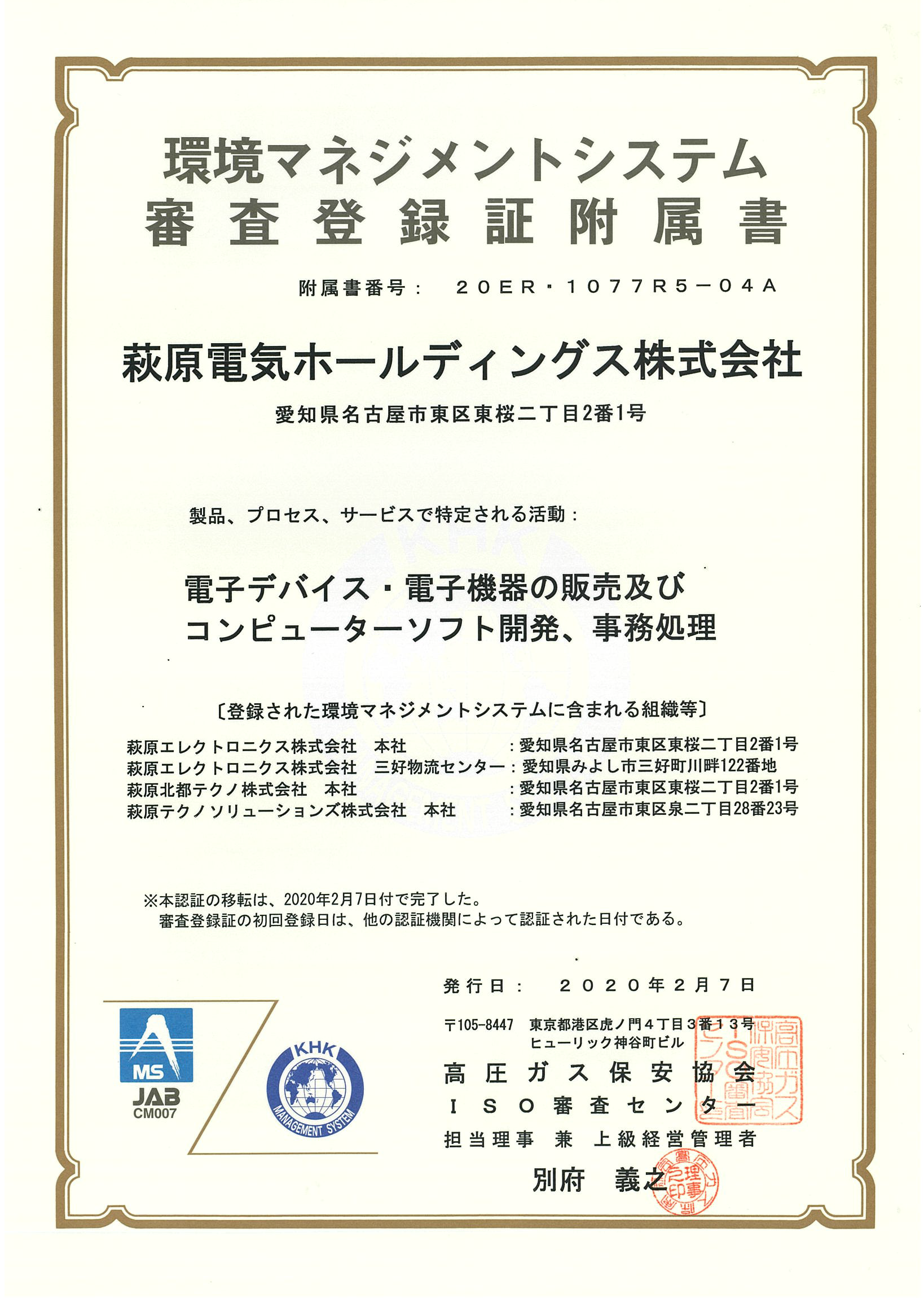
- 個人投資家向けオンライン説明会の画面
-
Risk Management
Basic Approach
Based on the belief that it is essential to accurately deal with various risks that may have a significant impact on the management of the Hagiwara Electric Group, we are striving to develop and bolster our risk management system through measures that include identifying and preventing potential risks through communication with stakeholders and formulating measures to minimize damage in the event that risks materialize.
Risk Management System
Based on control and administration by the Sustainability Committee, we have established the Risk Management Committee at our group with the aim of promoting company-wide risk management. The Chairperson of the Committee is appointed from among the members of the Board of Directors. The Risk Management Committee meets once every quarter, primarily composed of members appointed by the Chairperson, with participation from Audit and Supervisory Committee members and heads of the Internal Audit Department. The main activities and key matters discussed by the Risk Management Committee are reviewed by the Sustainability Committee, and depending on their significance, resolutions are made by the Board of Directors. This process ensures appropriate oversight and guidance by the Board.
In recognition of the importance of information security and disaster prevention/BCP (Business Continuity Planning), we have established cross-functional frameworks for individual initiatives. These frameworks enable the identification of risks and consideration of countermeasures from specialized perspectives. Through appropriate activities in each area and the organic collaboration between committees and departments, our group strives to comprehensively identify risks and implement appropriate measures to mitigate them, thereby enhancing the effectiveness of our overall risk management system.
Risks to the Operations of the Hagiwara Electric Group
The following 13 items have been identified as risks to the operations of the Hagiwara Electric Group, based on discussions at meetings of the Board of Directors of Hagiwara Electric Holdings Co., Ltd., and these countermeasures are defined.
- Risks related to the automotive industry
- Risks from dependence on specific customers
- Risks from dependence on specific suppliers
- Risks related to product quality
- Risks related to new businesses
- Risks related to inventory valuation losses
- Risks related to the impairment of fixed assets
- Risks related to exchange rate fluctuations
- Risks associated with overseas activities
- Risks due to natural disasters
- Risks related to compliance
- Risks related to information security
- Risks related to personnel recruitment
BCP (Business Continuity Plan)
We have established a Risk Management Committee with the aim of enabling accurate management and practical responses to various risks that may affect the Group’s business operations. In addition, we have formulated Risk Management Regulations and developed a comprehensive risk management framework. The Risk Management Committee identifies key risks and initiates efforts to mitigate them.
As part of the Business Continuity Plan (BCP), we conduct annual safety confirmation tests and evacuation drills for all employees. Furthermore, tabletop exercises and mobilization tests are carried out as needed for members of the Disaster Response Headquarters.
In terms of information security measures, we implement targeted email attack simulations, cyber incident response drills based on emergency scenarios, and enhanced security protocols in line with the introduction of remote work systems.
Information Security
Basic Approach
The Hagiwara Electric Group recognizes that ensuring information security is one of the most important issues the Group face, and we have established a basic policy on information security with the aim of protecting the Group's information assets.
Information Security Basic Policies
- To promote information security, monitor its status, and implement necessary countermeasures, we have established an Information Security Committee and appointed a Chairperson of the Committee as the responsible officer. Each department head assigns an Information Management Officer, who is responsible for promoting information security within their respective departments. These officers are tasked with protecting information from unauthorized disclosure, tampering, and service disruption.
- We implement optimal security measures to address events that may compromise the confidentiality, integrity, and availability of its information assets.
- We comply with all laws, regulations, and rules related to information security.
- We provide necessary education and training to promote a high level of understanding and awareness of information security.
- We continuously review and improve our information security measures.
Information Security Promotion System
Under the supervision and management of the Sustainability Committee, the Group has established a Group Information Security Committee, which discusses information security measures and matters to be considered, compiles measures to be implemented, and works to enhance risk management, etc. It also conducts information security training for all Group employees to ensure awareness and diligence regarding information security.
Measures and Initiatives
The Hagiwara Electric Group implements systemic measures such as antivirus and Endpoint Detection and Response (EDR), information security education for all Group employees, and targeted attack e-mail training. We raise the security awareness of each employee so that they can respond to cyber attack risks that become more sophisticated every day.
Information security training
| Targets | Contents | |
|---|---|---|
| Level-specific training |
New employees |
Provide essential information security training at key career milestones, such as onboarding and promotions, etc. |
| Information security training (e-learning) |
All executives and employees |
Conduct annual information security training to enhance awareness across the entire global organization |
| Targeted attack e-mail training |
All executives and employees |
Disseminate pseudo attack emails at irregular intervals and keep track of the status of open emails, to alert employees and improve their awareness |
Compliance
Basic Approach
As a prerequisite for taking on challenges and reforming, all our group employees have a strong sense of responsibility as members of society and will ensure thorough compliance.
Basic Policies
The Hagiwara Electric Group has established the Hagiwara Electric Group Corporate Code of Conduct and the Hagiwara Electric Group Corporate Code of Behavior as its basic policies for compliance, and it has established policies and guidelines for individual matters to ensure thorough compliance. (These include the handling of personal information, preventing harassment, revenue recognition accounting standards, subcontracting operations, and export license applications.)
Compliance Promotion System
Under the supervision and management of the Sustainability Committee, the Group has established an Internal Control Committee, which regularly examines the adequacy and effectiveness of compliance and internal management systems, improves and corrects problems, and works to enhance internal control and compliance-related risk management, etc. Furthermore, this committee implements compliance education for the employees of all group companies, and thereby works hard to ensure thorough legal compliance.
Main Initiatives
Compliance-related Training and Education
The Hagiwara Electric Group conducts a variety of training programs, including compliance training, for all Group employees in order to familiarize them with our policies and improve their understanding. We are also striving to strengthen our systems through complementary measures, such as our whistleblowing system and intellectual property checking management (to avoid the risk of patent infringement).
- Compliance training (once per year)
- Information security training (once per year)
- Subcontracting Proceeds Act lecture (once per year)
- Security trade control lecture (once per year)
- Holding e-learning lectures on legal affairs
- Sending out compliance-related reports
…and more
Internal Reporting System
To strengthen our compliance framework, we have established a Corporate Ethics Hotline as part of our internal reporting system.
The reporting channel is operated by an external outsourcing provider, ensuring that any reports received are promptly communicated to the appropriate personnel within the Company. Reports can be made anonymously. Those responsible for investigating and addressing internal reports are required, under internal regulations, to strictly manage the content of the report, the investigation process, and any related evidence. Retaliation or any disadvantageous treatment against whistleblowers is strictly prohibited. In addition, the operation of this system is independently monitored by outside Directors to ensure fairness and transparency.
Anti-Corruption
The Hagiwara Electric Group does not engage in bribery, the improper provision of benefits, or the giving or receiving of undue advantages in any business transactions. We comply with applicable laws and international standards to ensure fair and transparent business practices. We also promote understanding of anti-corruption principles among all directors and employees and take strict action in the event of any violations.
Responsible Minerals Sourcing
The Hagiwara Electric Group recognizes that issues related to conflict minerals pose significant risks, including regional conflict, environmental degradation, and human rights violations. We acknowledge the importance of respecting human rights and ensuring responsible procurement in the international community. To confirm that the products we handle do not contain conflict minerals, we cooperate with supply chain surveys and work to promote responsible sourcing practices.
Framework for the Elimination of Anti-Social Forces
Our group has established and thoroughly communicated the Hagiwara Electric Group Corporate Code of Conduct, which states that we will conduct business activities in accordance with laws, social norms, and common sense, and that we will not engage with any individuals or organizations that may negatively impact social order or the sound operation of our business.
Furthermore, we have established the Anti-Social Forces Countermeasure Regulations and built a framework to eliminate anti-social forces, with the General Affairs Department serving as the designated contact point. We are a member of the Aichi Prefectural Council for the Elimination of Violence and actively participate in seminars. In addition, we collaborate with the Prefectural Police Headquarters and local police stations to gather information and take action against anti-social forces. All executives and employees are required to submit a written confirmation stating that they have no ties to anti-social forces. For new business partners, we mandate a pre-screening by the Legal Department before any negotiations begin, and we also conduct regular rolling checks to ensure continued compliance.
As a general rule, we require the signing of a Basic Transaction Agreement that includes clauses for the exclusion of organized crime groups and other anti-social forces when engaging in ongoing business relationships. Through this approach, we are actively building and operating a framework to eliminate anti-social forces from our business activities.
Tax Transparency
The Hagiwara Electric Group recognizes that ensuring transparency in corporate accounting and fulfilling appropriate tax obligations are important responsibilities. Based on this approach, we carry out our tax-related operations in accordance with the following principles.
- Compliance with Laws and Regulations
We comply with tax regulations and do not engage in interpretations or practices that deviate from the intent of the law or result in tax avoidance. - Transparency
We comply with the tax laws and regulations of the relevant countries and regions, accounting standards, and other international rules such as the OECD Guidelines. We also report and disclose tax-related information appropriately.


















